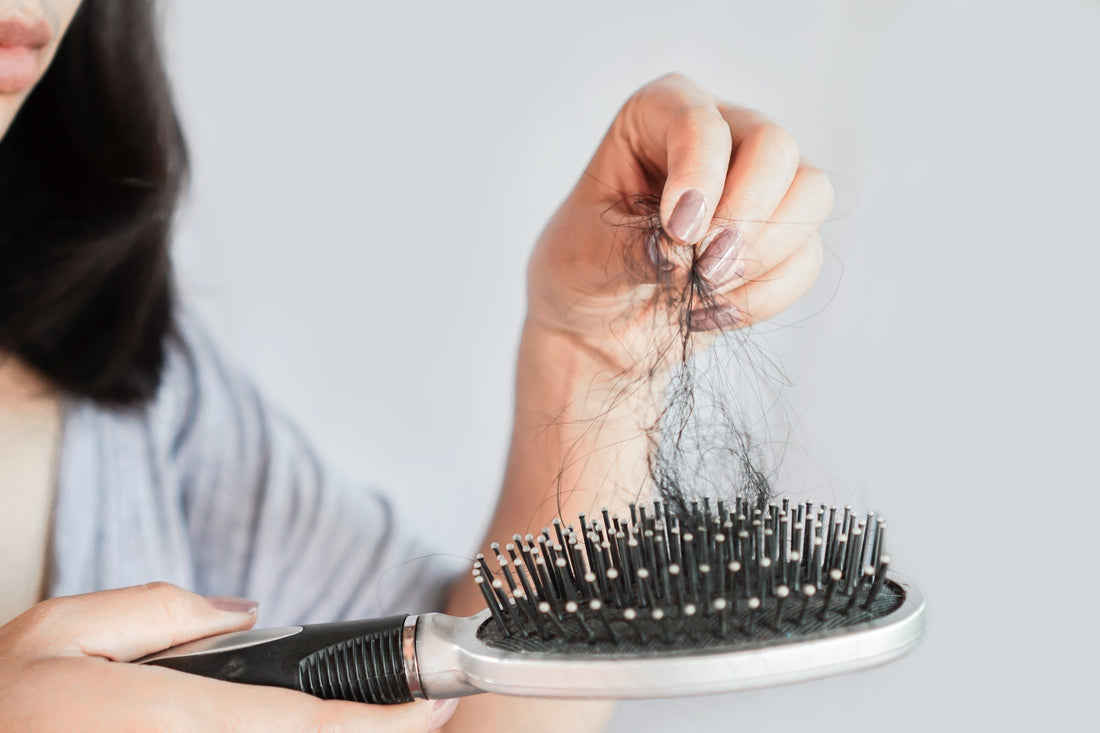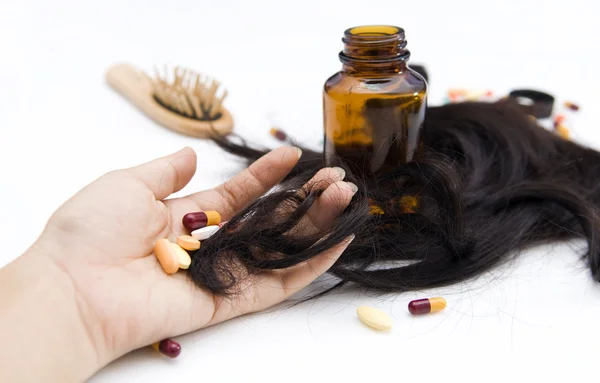
Ozempic and Hair Loss: Why GLP-1 Medications Cause Shedding and How to Fix It
Share
For many women, starting a GLP-1 medication feels like a turning point. After years of dieting frustration, you’re finally watching the scale drop. Your blood sugar is improving, your energy is more stable, and you’re excited about the transformation ahead.

Then it happens: clumps of hair in the shower drain, a thinner ponytail, or even scalp visibility where you never noticed it before. Understandably, panic sets in. Is Ozempic causing my hair loss? Will it stop? Can I do anything to fix it?
The answer: yes, hair loss on GLP-1s is real — but it’s temporary and manageable. In this article, we’ll break down:
- Why hair loss happens on GLP-1 medications
- The science behind the hair growth cycle
- What you can do right now to stop shedding
- How long it lasts (and when to see a doctor)
- Real stories from women experiencing the same thing
The Link Between GLP-1s and Hair Thinning

GLP-1 receptor agonists like Ozempic®, Wegovy®, and Mounjaro® help with weight loss by slowing digestion and reducing appetite. The result? You eat fewer calories, feel full longer, and the pounds come off quickly.
Clinical trials show that GLP-1 users lose an average of 15–20% of body weight over 68 weeks, making them some of the most effective weight-loss medications available.
But here’s the tradeoff: rapid weight loss, combined with reduced nutrient intake, can stress your body in ways that directly impact your hair.
Common reasons hair loss occurs on GLP-1s:
- Caloric deficit: The body enters a stress state, prioritizing survival over hair growth.
- Lower protein intake: Smaller appetites often mean less protein for strong follicles.
- Nutrient absorption: Slower digestion can reduce uptake of key vitamins and minerals.
- Hormonal shifts: Weight loss can trigger changes that disrupt hair cycles.
This doesn’t mean GLP-1s are “bad” for your hair — it just means you need to be proactive about supporting your body during this transition.
The Hair Growth Cycle: Why Shedding Happens
To understand GLP-1 hair loss, you first need to understand how hair grows:

- Anagen (growth phase): 85–90% of hair is here at any time, actively growing.
- Catagen (transition phase): A short resting period before shedding begins.
- Telogen (shedding phase): Old hairs fall out so new ones can grow.
Normally, only 10–15% of hair is in the shedding phase. But during stress — whether physical (rapid weight loss) or emotional (burnout) — the body can push 30–40% of hairs into telogen at once.
This condition, known as telogen effluvium, explains why shedding on GLP-1s often feels sudden and dramatic.
Why Your Body Puts Hair Last on the Priority List
Biologically, hair isn’t essential for survival. When resources are limited, your body will always prioritize the heart, lungs, brain, and muscles over your follicles.

On GLP-1s, this can look like:
- Protein deficiency: Without enough amino acids, keratin production slows.
- Micronutrient gaps: Low levels of iron, zinc, or vitamin C weaken follicles.
- Dehydration: Slower digestion may reduce water intake → brittle, dry strands.
- Stress response: Weight loss elevates cortisol, disrupting the hair cycle.
Studies suggest that up to 35% of people who lose more than 10% of body weight rapidly experience some degree of telogen effluvium.
This explains why many women don’t notice hair loss immediately after starting GLP-1s — it often appears 2–3 months in, when these imbalances catch up.
Hair Wellness on GLP-1s: Prevention Tips You Can Trust
The good news: hair loss on GLP-1s is not permanent. With the right steps, you can minimize shedding and encourage regrowth.
1. Prioritize Protein

Protein is the single most important nutrient for hair growth. Aim for at least 1 gram per pound of your goal weight.
👉 Example: If your goal weight is 150 lbs, aim for ~150g of protein daily.
Not into thick shakes? Try:
- Clear whey protein waters with fruity flavors
- Protein-rich Greek yogurt or cottage cheese
- High-protein cereals or granola toppings
- Protein bars with 15–20g per serving
- 2. Replenish Essential Nutrients

Collagen, ceramides, hyaluronic acid, and antioxidants support both hair and skin health. Together, they help maintain follicle strength, hydration, and elasticity.
Consider foods and supplements rich in:
- Collagen peptides → build hair and skin structure
- Ceramides → protect scalp barrier health
- Hyaluronic acid → hydration from the inside out
- Zinc & Vitamin C → repair tissues and reduce shedding
3. Stay Consistently Hydrated

Hair is 25% water by weight. Even mild dehydration can cause brittle strands. Aim for at least 64 oz (2 liters) daily — more if you’re active.
4. Manage Stress Levels
Cortisol, the stress hormone, is a major trigger for telogen effluvium. Build daily habits like:
- Meditation or deep breathing
- Journaling or gratitude practice
- Sleep hygiene (7–9 hours nightly)
- Gentle exercise like walking or yoga
5. Supplement Smartly

Even with the best diet, it can be tough to meet every nutritional need on GLP-1s. That’s why I formulated RestoreRx — to fill in the exact gaps that lead to hair, skin, and glow problems.
With collagen, hyaluronic acid, ceramides, and stress-fighting nutrients, RestoreRx helps your body keep up with the demands of weight loss so you don’t have to sacrifice your glow.
How Long Does Hair Loss Last on GLP-1s?
Most women find shedding peaks around 2–4 months in and improves by month 6–9. Once your body adjusts and nutrient intake stabilizes, shedding slows and baby hairs sprout.
Key takeaway: consistency matters. Don’t wait until shedding feels severe to act. Prioritize protein and nutrients early in your GLP-1 journey to reduce intensity.
Real Stories From Women on GLP-1s

Women across communities echo the same experience:
“My shedding hit me around month three. Once I upped protein and collagen, it slowed.”
“It felt scary at first, but I can see baby hairs coming back now.”
“Supplements helped me feel in control — instead of helpless.”
In surveys, nearly 30% of GLP-1 users report some level of hair shedding during rapid weight loss, but most also report regrowth within a year.
These stories remind us that while hair loss is frustrating, it doesn’t define your journey.
When to See a Doctor

Hair loss on GLP-1s is usually temporary, but you should see a doctor if:
- Shedding is severe or doesn’t slow after 6–9 months
- You notice fatigue, dizziness, or brittle nails
- You suspect thyroid issues or iron deficiency
A simple blood panel can check for deficiencies or hormonal imbalances.
Final Thoughts
Hair loss on GLP-1s is real, but it doesn’t have to steal your confidence. By prioritizing protein, nutrients, hydration, stress balance, and smart supplementation, you can protect your hair and your glow throughout your weight loss journey.
✨ Want to protect your glow while losing weight?
Join the RestoreRx waitlist today and take the first step toward stronger hair, healthier skin, and renewed confidence.
FAQs
Does Ozempic cause hair loss?
Indirectly, yes. Ozempic doesn’t damage follicles, but rapid weight loss and nutrient changes can trigger shedding.
Is GLP-1 hair loss permanent?
No. Telogen effluvium is temporary if addressed. Most women see regrowth in 3–6 months.
What’s the best way to stop hair loss on GLP-1s?
Focus on protein, hydration, micronutrients, and consider supportive supplements like RestoreRx.
When will my hair grow back?
Baby hairs often appear within 3–6 months after shedding starts. Full regrowth may take 9–12 months.
Can supplements really help?
Yes, especially when they target the common gaps with GLP-1 use — collagen, ceramides, hyaluronic acid, and stress-balancing nutrients.
The information provided on this website is for educational purposes only and is not intended as medical advice. It should not be used to diagnose, treat, cure, or prevent any health condition. Always seek the guidance of your physician or other qualified health provider with any questions you may have regarding your health, medical conditions, or before making any changes to your diet, supplements, or treatment plan. Never disregard professional medical advice or delay seeking it because of something you have read here.